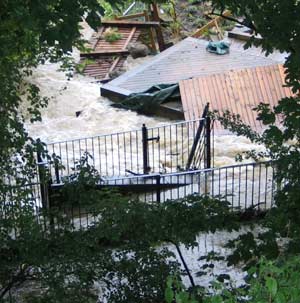
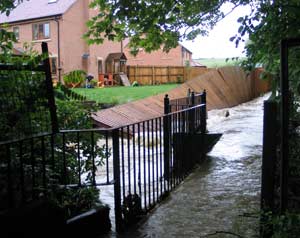 BY
THE TIME I TOOK these photographs, late this afternoon, the flood on Coxley
Beck had subsided. A square of garden decking (left), undermined
by the flood, looks like a beached raft. The stout timber fence collapsed and
curled like a strip
of
ribbon as the beck burst its banks.
BY
THE TIME I TOOK these photographs, late this afternoon, the flood on Coxley
Beck had subsided. A square of garden decking (left), undermined
by the flood, looks like a beached raft. The stout timber fence collapsed and
curled like a strip
of
ribbon as the beck burst its banks.
Flood warnings for local rivers weren’t
issued until the early hours of the morning and the flood was at its height
when the first dog walkers of the day found that the footpath into Coxley Valley
had
turned into a watercourse.
The rush of the water sounded like a distant train.
'One has to feel sorry for some of the new residents of Coxley
Dell (who have only moved in within the past year),' wrote my neighbour, Derek
Hale, in a letter to the local paper, 'who awoke this morning to find
the bottom of their gardens part of a raging river. It's not the sort of thing
you would
expect after paying over £400,000 for your dream home'.
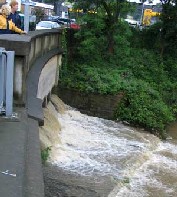 Overflow
Overflow
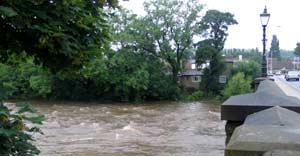 The
River Calder (left) is high, although
it's not up to its November
2000 levels, however it's risen enough to block the culvert that flows under the
canal and into the river by the Bingley Arms, next to the bridge. When this
happens, water cascades through an overflow (right) into the canal.
In 2000 the canal was unable cope with the flow and Coxley Beck soon started
to pond up back towards the meadow. Smithy Brook Beck which joins it under
the old railway viaduct adds to the bottle-neck effect.
The
River Calder (left) is high, although
it's not up to its November
2000 levels, however it's risen enough to block the culvert that flows under the
canal and into the river by the Bingley Arms, next to the bridge. When this
happens, water cascades through an overflow (right) into the canal.
In 2000 the canal was unable cope with the flow and Coxley Beck soon started
to pond up back towards the meadow. Smithy Brook Beck which joins it under
the old railway viaduct adds to the bottle-neck effect.
Worst Case Scenario
But the bottle-neck effect isn't the most serious scenario facing
the new houses. There are two earthen dams, too small to be
subject
to the
reservoirs
act,
a few hundred yards upstream. In past years on two occasions some neighbours
who live close to the beck have been woken in the middle of the night and told
by
the
police
that
they
should prepare to evacuate should one of the dams give way. Their house is
on a banking, several metres higher than the new development.
Local residents and councillors have long been aware of these
flooding dangers and brought up the matter at a public enquiry but the information
was
never passed on to the Environment Agency:
‘At
the time of consideration of the planning application the Agency was unaware
of concerns regarding the dams’ said Jeff Meynell, Development
Control
Officer of the Environment Agency in December 2001. Surprisingly,
since they'd already approved the development, he added; 'We
do
not
have any sections showing how the site will be set out.'
I'm glad
I didn't buy one of the houses. It seems like a disaster waiting to happen,
one that could so easily have been avoided.
Brookside Ecology
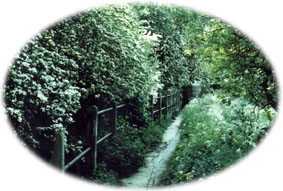
 In
February 2001 an ecologist surveyed this stretch of the beck (left, as
it was before the development),
netting Bullhead (right),
a protected species of fish, and identifying 'several ancient woodland herbs
. . . Ramsoms, Opposite-leaved
Golden Saxifrage and Dog's
Mercury'. As it was winter, he missed the stand of Purple
Loosestrife that
made such a show in the corner of the meadow during the summer.
In
February 2001 an ecologist surveyed this stretch of the beck (left, as
it was before the development),
netting Bullhead (right),
a protected species of fish, and identifying 'several ancient woodland herbs
. . . Ramsoms, Opposite-leaved
Golden Saxifrage and Dog's
Mercury'. As it was winter, he missed the stand of Purple
Loosestrife that
made such a show in the corner of the meadow during the summer.
Here's what he concluded:
‘
The following are recommended for the landscaping of both banks of Coxley Beck
along the beck corridor site: -
1. All existing semi-natural vegetation and
native species, including trees, shrubs and herbs should be retained. Reason:-
to maintain the existing semi-natural
conditions.
2. There should be no planting of trees or shrubs along either
side of the beck and no planting of non-native species nearby. Reasons:-
Non-native species
should not be introduced to the existing semi-natural vegetation and any
tree or shrub planting would increase shading of the beck and its margins
to the
detriment of its flora and fauna. The best way to conserve the Bullhead
and its habitat is to prevent excessive shading of the water-course and its
banks.
Natural regeneration of existing vegetation should be encouraged
and allowed to proceed without intervention and artificial management.'
Wake-up Call

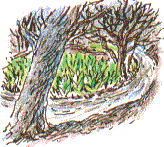 So
many trees have been felled around the site, and Bellway Homes have obliterated
every wild flower and ancient woodland herb on their bank of Coxley Beck. Recently
weedkiller has been sprayed on the Himalayan balsam alongside
the Gypsy Lane footpath; a questionable way to encourage natural regeneration.
So
many trees have been felled around the site, and Bellway Homes have obliterated
every wild flower and ancient woodland herb on their bank of Coxley Beck. Recently
weedkiller has been sprayed on the Himalayan balsam alongside
the Gypsy Lane footpath; a questionable way to encourage natural regeneration.
The ecologist's statement was endorsed by Wakefield Council at the
reserved matters meeting that gave
the
go-ahead
for
this development.
I think this flooding shows how
important it is to restore the beckside to its natural state. That is, after
all, what the developer and the council originally agreed to do.

 BY
THE TIME I TOOK these photographs, late this afternoon, the flood on Coxley
Beck had subsided. A square of garden decking (left), undermined
by the flood, looks like a beached raft. The stout timber fence collapsed and
curled like a strip
of
ribbon as the beck burst its banks.
BY
THE TIME I TOOK these photographs, late this afternoon, the flood on Coxley
Beck had subsided. A square of garden decking (left), undermined
by the flood, looks like a beached raft. The stout timber fence collapsed and
curled like a strip
of
ribbon as the beck burst its banks. Overflow
Overflow The
River Calder (left) is high, although
it's not up to its
The
River Calder (left) is high, although
it's not up to its 
 In
February 2001 an ecologist surveyed this stretch of the beck (left, as
it was before the development),
netting Bullhead (right),
a protected species of fish, and identifying 'several ancient woodland herbs
. . . Ramsoms, Opposite-leaved
Golden Saxifrage and Dog's
Mercury'. As it was winter, he missed the stand of Purple
Loosestrife that
made such a show in the corner of the meadow during the summer.
In
February 2001 an ecologist surveyed this stretch of the beck (left, as
it was before the development),
netting Bullhead (right),
a protected species of fish, and identifying 'several ancient woodland herbs
. . . Ramsoms, Opposite-leaved
Golden Saxifrage and Dog's
Mercury'. As it was winter, he missed the stand of Purple
Loosestrife that
made such a show in the corner of the meadow during the summer.
 So
many trees have been felled around the site, and Bellway Homes have obliterated
every wild flower and ancient woodland herb on their bank of Coxley Beck. Recently
weedkiller has been sprayed on the Himalayan balsam alongside
the Gypsy Lane footpath; a questionable way to encourage natural regeneration.
So
many trees have been felled around the site, and Bellway Homes have obliterated
every wild flower and ancient woodland herb on their bank of Coxley Beck. Recently
weedkiller has been sprayed on the Himalayan balsam alongside
the Gypsy Lane footpath; a questionable way to encourage natural regeneration.